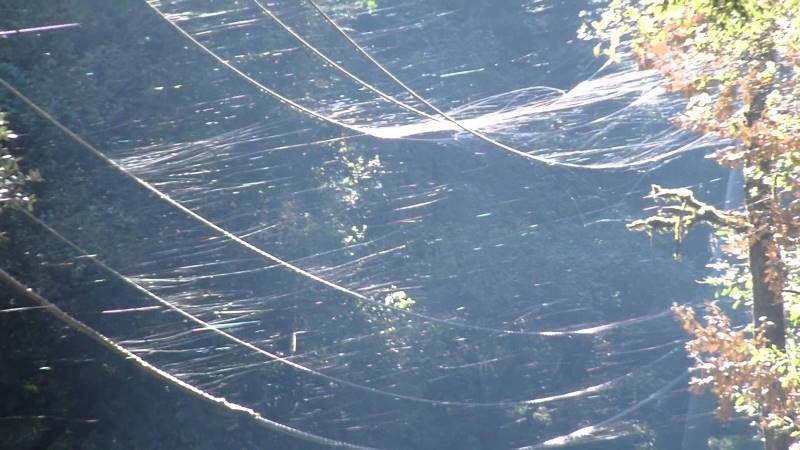
But Erica Morley and Daniel Robert have an explanation. The duo, who work at the University of Bristol, has shown that spiders can sense the Earth's electric field, and use it to launch themselves into the air.
Every day, around 40,000 thunderstorms crackle around the world, collectively turning Earth's atmosphere into a giant electrical circuit. The upper reaches of the atmosphere have a positive charge, and the planet's surface has a negative one. Even on sunny days with cloudless skies, the air carries a voltage of around 100 volts for every meter above the ground. In foggy or stormy conditions, that gradient might increase to tens of thousands of volts per meter.
Ballooning spiders operate within this planetary electric field. When their silk leaves their bodies, it typically picks up a negative charge. This repels the similar negative charges on the surfaces on which the spiders sit, creating enough force to lift them into the air. And spiders can increase those forces by climbing onto twigs, leaves, or blades of grass. Plants, being earthed, have the same negative charge as the ground that they grow upon, but they protrude into the positively charged air. This creates substantial electric fields between the air around them and the tips of their leaves and branches-and the spiders ballooning from those tips.
This idea-flight by electrostatic repulsion-was first proposed in the early 1800s, around the time of Darwin's voyage. Peter Gorham, a physicist, resurrected the idea in 2013, and showed that it was mathematically plausible. And now, Morley and Robert have tested it with actual spiders.
First, they showed that spiders can detect electric fields. They put the arachnids on vertical strips of cardboard in the center of a plastic box, and then generated electric fields between the floor and ceiling of similar strengths to what the spiders would experience outdoors. These fields ruffled tiny sensory hairs on the spiders' feet, known as trichobothria. "It's like when you rub a balloon and hold it up to your hairs," Morley says.
In response, the spiders performed a set of movements called tiptoeing-they stood on the ends of their legs and stuck their abdomens in the air. "That behavior is only ever seen before ballooning," says Morley. Many of the spiders actually managed to take off, despite being in closed boxes with no airflow within them. And when Morley turned off the electric fields inside the boxes, the ballooning spiders dropped.
It's especially important, says Angela Chuang, from the University of Tennessee, to know that spiders can physically detect electrostatic changes in their surroundings. "[That's] the foundation for lots of interesting research questions," she says. "How do various electric-field strengths affect the physics of takeoff, flight, and landing? Do spiders use information on atmospheric conditions to make decisions about when to break down their webs, or create new ones?"
Ed Yong is a staff writer at The Atlantic, where he covers science. Twitter Email



'Detection' or interactive communication of electric charge fields is the way things work.
The current gravitic based - no matter what layers of interpretation are overlaid or interposed as 'narrative'.
Narrative 'consensus' is a framing of the genie, so as to only allow those 'truths' that fit into the wishes of those who are most heavily invested and empowered to defend their investments - usually by the invalidating and disempowering of any other result than one thay can weaponize or marketize. But we also run our own 'intrapersonal' version of this and so I do not only call for holding OTHERS accountable for their choices - but our own participation and complicity - often running as 'unconscious habit'.
The loss of consciousness and health in terms of loss of voltage is masked over by the fragmenting of polarized and specialized or exclusive identities that SEEM to be a dynamic - but actually operate a choke or paralysis on the free awareness of desire in fulfilment that runs regardless our surface awareness of what we actually 'wishing for'.
The setting up of a consciousness of scarcity and lack is inherent to the wish of personal power - also known as the judgement or 'knowledge of good and evil - that operates an interjecting mind or narrative overlay upon the movement of being - also known as 'Is'.
Tesla tapped the solar capacitance as a matter of demonstration. Not to say there are not dangers in such endeavour.
These little spiders travel the stratosphere - often freezing and thawing en route. The great thing about mistaken foundations and fake science to fill in the 'dark bits' or 'holes' is the excitement and joy in discovering the true. But the negatively charged identity generates a negatively operating 'economy' where nothing true is affordable and only sickness, war, destruction and distraction 'pay'.